|
||||||||||||||||||
|
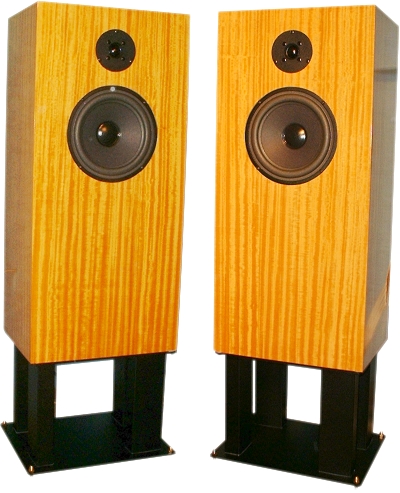
| PART 1 - Overview |
| Introduction |
Since then, I had been reading many good things about their speaker kits and just had to try one for myself.
The finished cabinets measure in at approximately 31-inches high x 14.25-inches wide x 10.5-inches deep. They are a rear ported, dual driver design originally based on the Snell type E speaker but refined since.
The speaker kits themselves do not include cabinets.
| The Cabinets |
I was in the process of exchanging e-mails with Peter Qvortrup (owner of Audio Note UK), asking his advise on some other aspects of my system when I happened to mention my problem. He then informed me that he still had some old design, factory made cabinets that were laying about the factory doing nothing and I was welcome to them. What's more, his wife would be visiting with relatives that weekend in my area and I could pick them up from her locally. Well, you can imagine my excitement! The big stumbling block had been overcome and I would have factory made cabinets too. I could now proceed with the speakers.
Now, to fill you in on this, the newest cabinets are made exclusively from muti-ply Baltic Birch (the top, bottom, front, back, and sides). The old style cabinets, that I would be getting, were the same Birch for the front and back but the top, bottom, and sides are made of MDF. I believe that the internal materials used for bracing etc. are still the same. Audio Note changed over to the new cabinets only a few years ago and the changeover left some cabinets behind.
So, the time came to pick up the cabinets. They came boxed and unfinished. However, the bass ports had been fitted and the T-nuts, used to hold the drivers in place, had also been fitted.
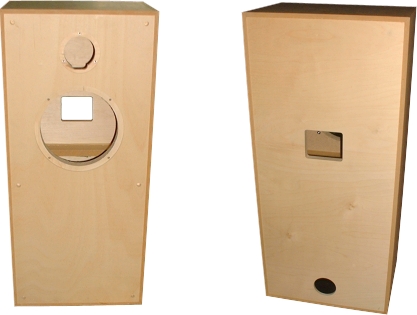
| Getting the Cabinets a Good Finish |
It looked like it would have to be a paint job but first, I decided to ask around about veneering. So, I looked around on the web and contacted a few companies that I came across but they all dealt with panel veneers. I then turned my attention to cabinetmakers as a search criterion and found one that lived very close by. His name is Mark Hopkins and he makes and restores furniture. So, I went down to see him and saw some of his wonderful work - most impressive. We discussed my requirements and he showed me a whole bunch of veneer samples that he had. We settled on an African Satinwood that he used a lot because of the way the grain seems to move when you do - giving it a kind of holographic quality. It would take two weeks to complete.
Two weeks later, I arrived to pick them up. They looked stunning under his workshop lights, I couldn't have been happier. He had spent days French polishing them to a high sheen.
He told me not to touch them for another two weeks to let the finish settle before doing anything with them.
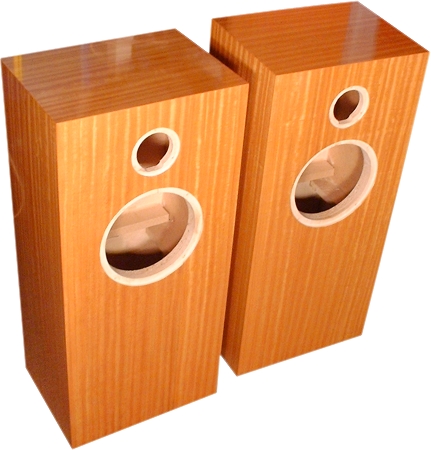
Mark has a website that doesn't do his work justice (or did at time of writing) - so I decided to set-up a page on my site that would show off some of his work in a better light - as well as linking to his website. So, click here to view some of his work in a new window.
I must also say here that I have had a lot of trouble photographing these cabinets. Everytime I take a picture of them, they end up looking totally different and I've not yet been able to take one that actually looks like the real thing or does them justice - sorry.
| Differences of Opinion |
The cabinets are actually designed to resonate to a certain degree whereas most other manufacturers do their best to completed deaden their cabinets. This should be looked upon as being similar to the way an acoustic musical instrument resonates. It does, however, mean that the cabinet designs must be adhered to accurately and within the specified tolerances when building them - placing the internal bracing a few millimetres out of tolerance, for example, could significantly affect the cabinet's 'tuning'.
Audio Note also spends a great deal of time matching and adjusting the drivers to the crossovers and to each other. More so on their finished product speakers, of course. Their finished products are matched to within 0.2dB of each other whereas the kits are tuned to 0.6dB of each other - which is said to be better than most other manufacturers' finished products. Sometimes the kit speakers are ones that were originally destined to be part of a production speaker but didn't quite meet the ultra-tight tolerances.
Indeed, one of the most often heard comments about Audio Note's speakers, that I have heard, is how well the tweeter and woofer integrate because so much time has been spent tweaking the crossovers to make the smoothest possible overlap between drivers.
Audio Note also believes that a 2-way speaker is the best way to go. They state that it is difficult enough to balance two drivers correctly; never mind three or four or more.
| The Audio Note Speaker Kit Range |
- Kit01 - This is a kit of only crossover parts, drawings, description, and port tube.
- Kit02 - This is their standard efficiency kit. It comes in 4 variations with combinations of copper or silver coils and Black Gate options.
- Kit03 - This is the high efficiency kit. It uses silver voice coils for both the tweeters and woofers. There is a standard and Black Gate version available.
The kit featured here is the SPKR-KIT-03, the standard version of the Kit03.
The SPKR-KIT-03 is described on Audio Notes website as 'Built, tested and calibrated crossover with matched silver voice coil tweeter and new 98dB efficient woofer also silver voice coil with AN-E cabinet drawings and port tube'.
Audio Note has also just release a new cone material for some of their finished product drivers. These use hemp instead of paper. I don't know for sure whether the new drivers will make it into the speaker kits but it may be worthwhile enquiring if you intend to build one yourself. The hemp drivers are easily recognised because their cones are a distinctive blue colour.
| PART 2 - The Build |
Once you have the cabinets, the build itself is quite simple. There are just three things to bear in mind:
- Keep the matching tweeter/crossover/woofer together - don't mix them up with the ones intended for the opposite channel.
- Fit the supplied wadding in the way described.
- Pay special attention to sealing everything correctly and effectively.
Each component is marked with a numeric identifier that was put there at calibration time. This is done so that you can be certain which component belongs to which to keep them in their matched groups.
Each sheet of wadding must be cut in a specific way so as to end up with three pieces. These must be fitted as described. The wadding is not actually fixed to the inside of the cabinets. Instead, they are arranged in such a way that allows them to stay where they are put without glueing or tacking. This is done intentionally so as not to alter the resonant qualities of the cabinets.
The rear connection panels also carry the hard-wired crossovers. Hard-wiring allows wire lengths to be kept to an absolute minimum. This, and the drivers, must be fixed so that a good seal is maintained. The sealant that is supplied is Blu-Tack - apparently considered the best DIY, low cost alternative to the more exotic materials used by Audio Note for their production speakers. The Blu-Tack does actually seem to work very well for this purpose - although I probably went a little over-the-top when I used it to seal the rear panels (see build process link below).
Another thing to bear in mind is that when tightening the drivers, an even force should be applied - tightening each screw a little at a time so that pressure is evenly applied to the sealing material. It is also stated that you should not over-tighten because a degree of 'flexibility' is required between the cabinet and the driver basket.
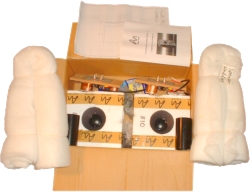
|
The speaker kit comes in a heavy, well packed box with everything you need to complete your speakers (except the cabinets themselves). A set of cabinet plans are included for those who wish to build their own.
Apart from the manual, cabinet plans, screws, terminal link wires, and T-nuts, there are two of everything as you would expect. All of the active parts are marked with a numeric group identifier - in my case these were 017 and 018. The crossover, tweeter, and woofer are all marked like this so as to avoid accidental mixing of the calibrated pairs. |
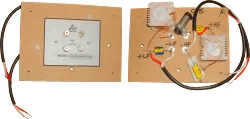
|
As well as providing the the speaker connections, the rear panel also houses the hard-wired crossover - keeping wire lengths to an absolute minimum.
There are 4 speaker terminals in-all per speaker. This is so that they can be wired in a variety of different ways - including bi-amping. For normal operation, the HF and LF terminals are shorted using the supplied heavy guage link wires. The other possible wiring configurations are shown in the manual. |
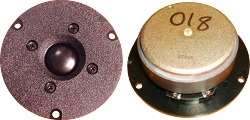
|
This is a high quality 1-inch, soft dome tweeter. The voice coils are wound with silver wire.
Total overall diameter is approximately 94mm. |
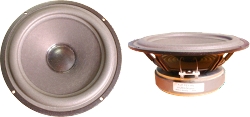
|
This is an 8-inch, high efficiency woofer which too has a silver voice coil. It allows for an efficiency of around 98dB/w/m.
|
All-in-all the build was both simple and enjoyable. The build process can be viewed in more detail by following the build link at the bottom of this page.
| PART 3 - Performance |
| Initial Impressions |
I immediately noticed totally different treble qualities - it was now less horn-like and much wider ranging. Much more detail could now also be heard overall. The sound was lighter and more 'airy'.
One of the best things that can happen to you when you first hear a new piece of kit is that you hear something that you have never heard before on a very familiar recording. Well, that is exactly the thing that happened on the very first track I played. I suspect this is due to the fine integration between the woofer and tweeter and also shows up a 'gap' in Tannoys' frequency response - something I had been told about being a shortcoming of dual concentric/integrated speakers.
The one negative thing that I noticed was that there was a lack of lower bass in comparison with what I was used to - although the bass that was there was far more controlled and detailed.
I was to discover over the next few days that the lack of bass was simply due to the driver bedding-in and becoming looser because the deepness of the bass increased dramatically over that time. At first I had visions of trying to move the speakers closer to the walls and corners, which is the recommended way of increasing bass response, but they now give out quite enough bass for me where they currently are (which is about 9 inches from a rear wall and angled in slightly).
With the increase in efficiency, I was expecting the speakers to be louder than the Tannoys position-for-position on the dial but, in fact, this was not the case. Instead, the extra efficiency seemed to simply increase the level of detail available. This was actually a relief because I had never been able to take the Tannoys past the half-way mark on the volume control of my PQ Kit1 amplifier anyway.
As I have just stated, there was a point to which I could never take the Tannoys past in terms of volume - this was because the sound would become too muddled and distorted. I always put this down to overloading the room. However, I found that I could now play music at much higher volumes without such problems and the sound would remain very clear and not become 'painful' in any way.
I intentionally listened to a wide variety of music over the next couple of weeks as well as listening to both analog and digital sources. I now find my system even more listenable than ever before.
| Rock |
Now onto a well mastered rock album - Steve Vai's Passion and Warfare. Sounds better than ever and every 'layer' of sound can be easily distinguished without infringing on others. Everything's as clear as a bell, separation is impeccable, and fast attack leading transients are handling with great speed. Playing this album on the Tannoys at high volume used to be a little tedious on the ears but because of the much-added clarity, these speakers make it very listenable and I no longer found myself reaching for the volume control to turn it down.
| Acoustic Music |
For some acoustic music that was much more demanding, I chose to listen to the Shakti albums Natural Elements and A Handful of Beauty. These have always been great favourites of mine, and feature John McLaughlin playing his unique sitar guitar, L Shankar on violin, Zakir Hussain on tabla, and others. This music is, to me, highly complex yet easy to listen to, very musical, and extremely well performed - incorporating a kind of unique mix between traditional Indian music and jazz with musicians who are all virtuosos in their own right. The portrayal of these albums on the Kit03's was much more together than with the Tannoys. The Tannoys tended to over-emphasise certain upper harmonics produced by the tabla and especially some of the other percussive instruments used (such as the 'pot'). The Kit03's presented a great image of the musicians that never got out of hand in even the most complex passages. The huge string bending and de-tuning of the sitar guitar done on track 3 of A Handful of Beauty (India) was great at showing the superb integration between the woofer and tweeter on the Kit03's.
| Orchestral Music |
I threw quite a full range of orchestral music at these speakers, finding it quite addictive and enjoyable. Never before had I had such satisfaction with orchestral pieces. The full might of the orchestra is handled with ease and presented gracefully but with adequate control and speed to compliment the sheer scale of large orchestral set-ups. Most pieces now begin with a deep breath in rather than silence as the musicians prepare for their first notes - a most noticeable difference from the Tannoys, as was the sound of pages turning etc.
Solo grand piano showed off the speakers' ability to reproduce its massive range of overtones.
Choral works were more exciting with a very noticeable upper range extension creating a very satisfying 'sparkle' to pieces.
| Jazz |
This gave me the excuse to listen to my all-time favourite album, Jaco Pastorius' first solo album (simply called Jaco Pastorius). To me, this is his best ever album and is one of those must-have albums that shows true musical genius (albeit a level of creative genius that was unfortunately not to last throughout his career for various reasons). Its fist track, Donna Lee, once again immediately showed up the ability of these speakers to reproduce a consistent and even response - never once accentuating any particular frequency band of the bass or exaggerating any of the harmonics from the congas (as the Tannoys always did in both cases). Every track, in fact, seemed to have a new breath of life.
Thereafter, I tried all kinds of genres from small acoustic trios to big bands and from solo jazz guitar to full-on jazz fusions (such as Weather Report, Steps Ahead, Return to Forever, Mahavishnu Orchestra, to name but a few). Everything was handled without a problem and all recordings had a new freshness to them.
| Conclusion |
If one thing has to be said it should be that these speakers are very musically involving. Forget comments about being better at any one thing than speaker X and not as good at another than speaker Y. It simply isn't like that. I could say, perhaps, that the Tannoys were better at reproducing a particular frequency band but if I did then I would be being foolish because the Kit03 speakers don't have any one particular band that they excel at, they are just well balanced throughout the entire range.
They also seem to have a kind of sparkle to them that doesn't just apply to the upper ranges. This makes acoustic tracks, especially, delightful as it brings out the natural vibration of the individual instruments. Perhaps some of this sparkle comes from the resonant features of the cabinets themselves? I am not sure but something nice, and out of the ordinary, is definitely happening.
Even at low volume levels, these speakers sound 'bigger' than the Tannoys and don't appear to emphasise any one particular area of sound reproduction. Instead, they present music in a most musical and effortless way that brings you very close to the original source. They are also capable of going very loud but without that overloaded, congestion that you find with so many other speakers.
I simply can't fault them as they totally outshine my old Tannoys and have brought a sense of musicality to my system that I have only heard a few times in the past at Hi-Fi shows. I recommend these speakers very highly indeed.
Apart from the cabinets (which I didn't have to build), they are a very simple build and should not present a problem to a great many people - perhaps making them an ideal build for people who don't feel confident enough to tackle their other, more electrically oriented kits. Remember, however, that the cabinets have to be built exactly to the plans. They can also be purchased pre-built from AudioNote Kits if you live in North America or Canada.
If you do not feel capable of building them, or aren't so inclined, then I would still recommend that you seek out an audition of a production model of the AN/E's. Either way, I think you will be highly satisfied as I am.
Speakers were once described to me as the windows on the sound. If this is the case then I can safely say that my windows have now most definitely been cleaned.
Written by Paul Brookes
Published 24th November 2006
| Turntable | Audio Note TT-2 |
| Arm | Audio Note Arm1 |
| Cartridge | Audio Note IQ2 |
| Phono Stage | Audio Note Kit1 Phono Stage Signature |
| Amplifier | Audio Note PQ Signature Kit1 |
| Interconnects | Audio Note AN-v |
| Speakers | Audio Note Kit03 Speakers |
| Speaker Cable | Unknown silver multi-stranded |
| CD Transport | Audio Note CDT-One |
| DAC | Audio Note DAC Kit 2.1 Level B Signature with USB |
| Links |
| Audio Note Speaker Kit03 Build Process |
|
|
